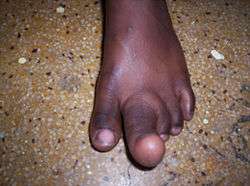Local gigantism
Local gigantism or localised gigantism is a condition in which a certain part of the body acquires larger than normal size due to excessive growth of the anatomical structures or abnormal accumulation of substances. It is more common in fingers and toes, where it is termed macrodactyly. However, sometimes an entire limb may be enlarged.

Causes
Local gigantism may be caused by a heterogeneous group of both congenital and acquired conditions.
Congenital
Congenital causes include:
- Klippel Trenaunay Weber syndrome
- Maffucci syndrome
- macrodystrophia lipomatosa[1]
- neurofibromatosis,[2][3]
- lipoatrophic diabetes.[4]
- Proteus syndrome, which by one theory accounts for the deformities of the Elephant Man
Acquired
There are a number of acquired causes of local gigantism. A body part can attain bigger size from causes as common as the following:
- inflammation, due to trauma or infection
- tumors like osteoid osteoma, melorheostosis, and lipofibromatous hamartoma[5]
- Arteriovenous malformations occurring on a limb, before the closure of epiphyses in long bones[6]
- Elephantiasis, which is quite common in south-east asia due to prevalence of filariasis.
- Still's disease
- amyloidosis
- acromegaly
Treatment
As the causes of local gigantism are varied, treatment depends on the particular condition. Treatment may range from antibiotics and other medical therapy, to surgery in order to correct the anatomical anomaly.
References
- Letter to the Indian Journal of Radiology and Imaging Archived September 7, 2015, at the Wayback Machine
- Lassmann H, Gebhart W, Mamoli B, Niebauer G (1977). "Nervous lesions in a case of local gigantism". Acta Neuropathol. 38 (2): 109–15. doi:10.1007/BF00688556. PMID 878849.
- Chung IH, Kim NH, Choi IY (1973). "Macrodactylism associated with neurofibroma of the median nerve. A case report". Yonsei Med. J. 14: 49–52. PMID 4804132.
- Some case reports
- Razzaghi A, Anastakis DJ (2005). "Lipofibromatous hamartoma: review of early diagnosis and treatment". Canadian Journal of Surgery. 48 (5): 394–9. PMC 3211895. PMID 16248139.
- Case report Archived May 14, 2006, at the Wayback Machine
External links
- "Gigantism". Medcyclopaedia. GE. Archived from the original on 4 February 2012. Retrieved 6 March 2006.